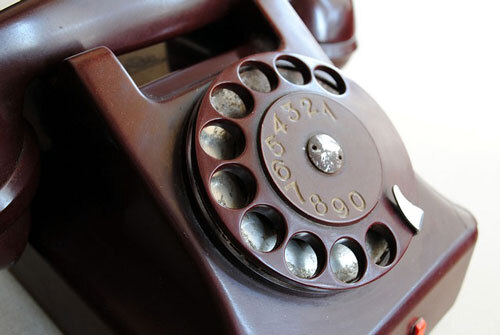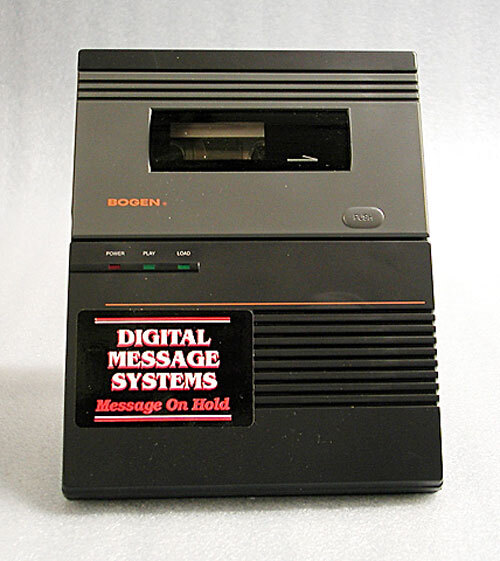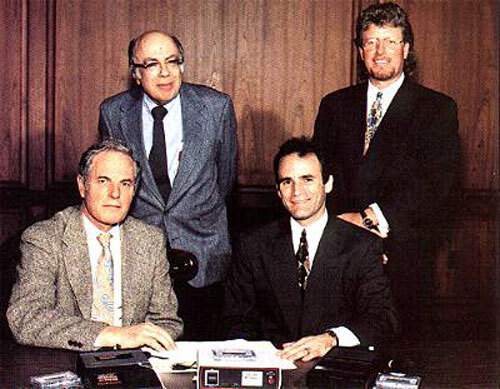Today in Tedium: This week appears to be the week when fast-casual sandwich chains are trying to out-weird one another. On Monday, Quiznos decided to announce a “Magic Mushroom Melt,” which looked to me like a sandwich from The Simpsons and that introduced me to the term “neon ranch.” (Perhaps they were inspired by Subway, whose “glowing eyelashes” commercial is permanently scarred in my brain. I beg you, Subway: Please stop airing it.) But perhaps an even weirder promotion came from Potbelly Sandwich Shop, which decided to replace the hold music on the office-conferencing service UberConference with songs intended to make you hungry for Mushroom Melts that aren’t magic, but at least don’t look disgusting. Potbelly’s promotion has inspired me—it’s finally time that Tedium looks seriously at hold music. We’ll be right back. — Ernie @ Tedium
Today’s GIF comes from the video for Mr Oizo’s “Flat Beat,” featuring lovable ad mascot Flat Eric.

(PublicDomainPictures/Pixabay)
The guy who invented hold music, then reinvented it two decades later
Recently, I’ve had a lot of opportunities to hear hold music, whether I’m waiting for my next conference call to pop up, I’ve had a question I needed answered, or I’ve been in dire need of customer support (looking at you IKEA).
I remember once when I called up a pizza place and the hold music, which played in a 10-second loop advertising the pizza joint, was so brain-numbingly grating that it made me want to stop eating pizza. (And I like pizza!)
Sure that hold music was annoying, grating, a punishment to brain cells, especially if it loops tightly or is particularly in-your-face, but you know what’d be worse? If there was no sound at all.
That was the point that a man named Alfred Levy made when he filed a patent application in 1962 for the “Telephone hold program system,” which is the very patent that led to the creation of hold music.
A 2014 Slate piece helpfully filled in the gaps on this story: Levy, a factory employee, stumbled upon the basic idea for hold music after a freak incident involving a wire and a steel girder. Oddly enough, when the wire touched the steel, it effectively turned the building into a giant radio, leading people on hold waiting for phone calls to actually hear music on the line, rather than waiting in silence.
It might sound far-fetched, but that’s the tale, apparently. Nonetheless, his patent filing, granted in 1966, does a great job of explaining why such a tool is necessary. He noted that switchboards and telephone operators increasingly were using hold buttons, which allow time to properly route calls through a switchboard. However, little consideration was being given to the person on the other end of the line, who understandably might get frustrated or concerned the call dropped if they don’t hear back after a while.
“Courteous telephone practice requires that a held caller be assured at reasonable intervals that the party to whom he wishes to speak still is busy but the pressure of her duties may prevent the operator from so advising the incoming caller so that he may be bereft of even this small consolation,” the patent filing stated. “In any event, listening to a completely unresponsive instrument is tedious and calls often are abandoned altogether or remade which leads to annoyance and a waste of time and money.”
A telephone hold system, he continues, is basically a way to pacify the person waiting for assistance, as it “assures the incoming caller that his call is being held and that he is not disconnected or forgotten.”
The timing of his invention was basically perfect, coming along right as the call center was making its first appearance.
On its own, Levy’s invention would be interesting enough, but he’s fascinating for another reason: He’s a two-time innovator. Two decades after his first patent related to this issue, he filed a second with fellow inventor Jon D. Paul, for a technology that allowed callers to decide which hold music they wanted to listen to.
The reason, of course, was obvious.
“Although the caller may listen for a brief interval regardless of the selection, if the holding interval is prolonged for some time, as is often the case, the caller may hang up, because he grows bored or because he dislikes the program being played,” the patent filing stated. “The caller may not call back, possibly resulting in the loss of good will and business for the subscriber.”
Some heroes don’t wear capes.
YES
The answer to the question of whether you should mute your phone while you’re on hold, according to a 2017 Lifehacker article. The reason, essentially, is this: While you might be on hold, the odds are good that the operator on the other end of the line can still hear you, and if you say something out of line, it can change the demeanor of the entire call.

(National Museum of American History)
The companies that really helped hold music take off
Sitting in the National Museum of American History (not currently on view, but there’s an entry online about it) is an item that not many people have actually seen, but if they lived through the ’90s, have likely heard in one way or another.
That device was called “Message on Hold,” and it helped to democratize hold music so that even small businesses could use it.
The image doesn’t seem to drop many hints, but diving into the brand names appear to tell one heck of a story.
Let’s start with the device itself: Made by a company named Bogen Communications, the device looks like any standard answering machine, but it actually plays music off a tape for those put on hold.
Bogen is an obscure brand, still around today, that sells niche audio products. At one point, it was directly affiliated with Presto Recording Corporation, one of the firms that had developed the coated aluminum record that proved the precursor to the vinyl record.
But after some corporate shifts, Bogen quietly became important in its own way. With the Bogen MMT series released in the early 1990s, the New Jersey firm was responsible for a key innovation in the world of hold music—the use of a microprocessor to help control the tape as it replayed. Eventually, the tape would go away and digital music would be used for everything.
It’s the kind of thing that’s genuinely historically important, enough to end up in a museum, but only if someone is observant enough to notice.

The Bogen hold music machine being introduced into the Smithsonian; the two men on the right are early hold music entrepreneurs Byron Lancaster and J.B. Seligman. (The Messages on Hold Network/Internet Archive)
Fortunately, one of Bogen’s customers made the realization that such a device deserved a spot in the Smithsonian. That firm, named Digital Message Systems, was one of the leading lights in the recording and distribution of hold music in the early 1990s.
Digital Message Systems, better known under its alternate name “The Message on Hold Network,” was one of a spate of companies to realize the importance of creating music and messaging specifically designed for being on hold.
It was common back in the day for hold music to literally get pumped in from the radio, just as it was on the fateful day when that wire touched Alfred Levy’s office building. (According to one early statistic from The Boston Globe circa 1987, 92 percent of hold music was sourced from the radio.)
But this approach eventually fell out of favor for a few reasons, including the fact that it’s widely believed to violate the copyrights of both the radio stations and the music creators. (ASCAP, for one, designates hold music as a “public performance” that would require copyright permission.)
Clearly, other music was necessary to help set the mood on the other end of the line.
But J.B. Seligman, Digital Message Systems’ cofounder, found another reason things needed to change. One day, he was on hold with his bank and heard a commercial for that bank’s competitor. Seligman, with a background in radio and a studio of his own, decided to record music specifically intended for being played on hold. Soon enough, according to The Tampa Tribune, Seligman moved to Florida, where he found a business partner, Byron Lancaster, that just as much into the idea as he was.
The potential was obvious, and Digital Message Systems was part of a mini-spate of companies trying to fill the hold-music gap. (Another such example cited by Slate, American Telephone Tapes, apparently relied on the frequent interruptions of a “sultry voice” to keep people on the line.)
“There are 10 million business telephone systems in this country,” Seligman told the newspaper. “With all the message-on-hold companies put together, there are only 100,000 accounts right now. That leaves 99 percent of the market wide open. It’s going to be extremely good for the next few years.”
Now, it should be said that the guys who ran this business, which appears to still be active today, were fairly colorful characters whose business careers took some pretty interesting turns.
The duo later launched a follow-up business called “Autographed To You,” which made it possible for fans to get personalized autographs from celebrities. It got more press than their careers as hold-music innovators—and it was arguably ahead of its time, given the fact that celebrities are selling access to shout-outs on the service Cameo, a service that is a third of the way to being a unicorn.
But not every step along the way was so easy. In 1997, Seligman and Lancaster filed a lawsuit against a drug store chain over the sale of a toy helicopter that they claimed to have patented—but the story dinged the duo for a wide array of details about their various bankruptcies, lawsuits, and tax issues. Clearly, these guys scored a hit with hold music, but success came with a weird backstory.
Putting the legal issues aside, Seligman’s background has left turns that really stand out, even for someone who became rich off of hold music: In the early ’80s, he was sued for patent infringement by the bar that was the setting for Urban Cowboy after he sold a mechanical bull. And decades after launching Digital Message Systems, Seligman re-emerged in a 2015 article in The Street, where he found himself living the high life in the expat hub of Bocas del Toro, Panama.
“I was looking for new adventures and a place to call home like Jimmy Buffett’s Key West 40 years ago,” he said. “I found both here.”
(You can’t say these guys have lived boring lives!)
Sure, the field of hold music evolved past these two firms, but for a time, they helped the medium evolve in important ways.
“Dick described the hold song as ‘haunting,’ but it was like a ghost none of us saw or even believed in. And he could tell.”
— Sara Corbett, a contributor to This American Life, discussing her father-in-law’s obsession with the hold music played by his medical system in a 2013 episode of the radio show. Corbett noted that there were other fans of this hold music, one of whom helped Dick figured out that it (as it turns out) was the default Cisco hold music, baked in since the ’90s. One of its employees during the era, Darrick Deel, recorded it with a friend, Tim Carleton, in 1989, and it was chosen by Cisco to be the default hold music for its telephone system offerings. Decades later, the music has gained a reputation as being the perfect hold song, due to its soothing qualities and non-grating nature.
Since the ’90s, the hold music field has evolved considerably, with a variety of firms involved in creating hold music in the modern day.
(Preemptively: If you’re a hold music company and you want your firm linked in this article, please don’t waste your time in reaching out!)
One interesting thing that kept coming up when reading about this is a weird statistic—usually claimed to be from CNN or a telecom trade group, but with no real source that I can actually confirm—that people are more likely to hang up and not call back if they hear silence.
Who knows if that’s true or not? Certainly, that was Alfred Levy’s original idea.
But the thing is, even if they don’t actually have that statistic in their back pocket, hold music companies can feasibly make the case that they have a good reason to exist—and it’s because hold music hits a specific musical need.
The things that make a hold song “good” are pretty much the opposite of what makes regular music good.
There are multiple reasons for this when you break it down. One of which is sound quality. The audio frequency range of traditional telephone systems is far narrower than that of what the human ear can support, meaning that voice quality can suffer significantly through telephone lines, let alone something that actually takes advantage of that frequency, like music.
In a 2017 clip, YouTuber and fellow cardinal red fan Tom Scott explained that this very limited range was a function of the phone company attempting to cut down on the number of wires it used as it attempted to automate the phone system, a problem that got worse as computers were used to compress audio signals—sometimes multiple times, in the case of hold music that has to go through mobile phone systems and corporate telephone networks.
(Ironically, a company system running on something like Cisco, which uses voice over internet protocol, or VoIP, compression technology, might be more likely to use higher-quality “wideband audio,” which extends the range significantly, though still far less than you’d get from a CD player.)
Which means that the nuance of music has to fit into a narrow range, and slick songs that try to do too much—like pretty much every pop song created in the last 30 years—get lost in the muddle. When it comes to hold music, simpler is better.
It’s part of the reason why the pizza place that tried to use blues to keep me satiated was so awful—the singer was going well beyond the range of what the telephone line could support. But not the whole part—a big chunk of the reason the hold music was so terrible there was because the loop was so tight, repeating the same 10 seconds or so over and over again. Perhaps the idea was that the hold time would be really short generally, but I think the time I waited was about five minutes, so I think I was in the mood to throw my phone across the room.
If you consider the songs that work well while you’re on hold, they tend to be formats widely considered “inoffensive” by listeners—think smooth jazz, or ambient music. They help color the phone line without becoming too grating.
And it’s really hard to get this right—especially when you’re attempting to get clever. This is something the state of Alaska learned when it tried to put modern artists into its hold music, including famed locals Portugal. The Man, whose “Feel it Still” was featured because it’s probably the biggest hit to come from an Alaska rock band, well, ever.
The problem was that people complained that some of the music was too grating or emotionally heavy for hold music. A conservative blogger complained, because of course a conservative blogger complained.
The program, soon enough, was put on hold—and then brought back, minus the controversial songs. Which stinks for the bands that the state’s arts officials were trying to give notice.
But, admittedly, there was kind of a point to that shift. Hold music carries a lot of weight for something that best works when it sounds weightless. Elliott Smith’s second album, while one of my favorite records, would make terrible hold music, for example.
The best hold music finds this middle ground, where it psychologically keeps you in the zone without driving you nuts in the process. It’s not perfect, but then again, you’re in an imperfect world where you can’t get what you want when you want it, anyway.
Look, they’re going to be ready for you when they’re ready for you. Let the classical strings or tinny synth take you away for just a moment.
But not too much—you have to be ready to interact with the telemarketer when they come back.
--
Find this one an interesting read? Share it with a pal! And see you later on this week.




